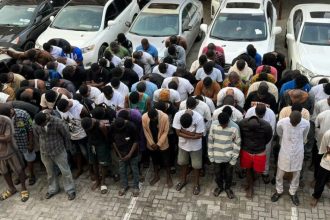Heavy rains have resulted in severe flooding and landslides in Nepal and India’s eastern Himalayan city of Darjeeling in the past few days.
Dozens of people have been killed in landslides in Nepal’s eastern hilly district of Ilam, which borders India. Local media reported that 41 families have been displaced in Nepal.
However, the government of Nepal’s interim Prime Minister Sushila Karki was praised for its response to the floods. Experts credited it with keeping deaths and destruction to a minimum.
Here is what we know.
How much rain has Nepal had?
Heavy downpours began on October 3, and data from the Department of Hydrology and Meteorology (DHM) show that some parts of Nepal experienced heavy rainfall. While the overall rainfall was slightly lower than last year, the destruction has still been bad because of “ultra-localised” heavy rains.
Pawan Bhattarai, an assistant professor at the civil engineering department of Kathmandu-based Tribhuvan University, told Al Jazeera that several districts in the central-eastern Terai plains and eastern hills bore the brunt of the storm, with weather stations in Rautahat and Ilam recording more than 330mm and 300mm of rain, respectively, on Saturday and Sunday.
Rainfall is normally considered extremely heavy if there is more than 150mm in 24 hours.
In the capital, Kathmandu, some districts received slightly more than 145mm of rain on Sunday compared with roughly 240mm in late September last year, when Kathmandu Valley experienced its heaviest deluge since 2002. Some parts of Kathmandu recorded as much as 322.2mm of rain last year, when the floods killed more than 200 people.
(Al Jazeera)
What caused the floods and landslides this year?
Various factors triggered the devastating floods this year.
Monsoon winds
Bhattarai explained that the flooding and landslides were an outcome of “an exceptionally intense and concentrated monsoon downpour”, which was caused by moisture-laden monsoon winds entering Nepal from the Bay of Bengal through the Indian states of Bihar and Uttar Pradesh.
As a result, very high amounts of rain fell in a short period of time in ultra-localised areas. Some areas received a lot of rainfall over a short duration, while other parts remained largely dry.
Topography
Compounding this, the topography of some regions in the country is not suited to heavy downpours, Bhattarai said. “The massive volume of water overwhelmed the flat plains of districts like Rautahat, Bara and Parsa, causing widespread flooding.”
These three districts are in the Madhesh province in the mid-south of Nepal, bordering India. They are situated on the Terai plains – a flat, arable area – making it vulnerable to flooding because they have little to no elevation to redirect floodwater.
“Simultaneously, the same intense rainfall destabilised the steep slopes of hilly districts like Ilam, triggering the fatal landslides. In contrast, other areas like Kathmandu received significantly less rain, highlighting the localised nature of this extreme weather event,” he added.
Poor infrastructure
“Unscientific infrastructure development – such as road expansions that destabilise slopes – and encroachment on natural landscapes have amplified the damage,” Bhattarai said.
He explained that the recurring landslides on the Narayangadh-Mugling highway have been exacerbated by inadequate planning, poorly designed roadwork and a lack of proper safeguards.
The Narayangadh-Mugling highway in central Nepal experiences landslides fairly frequently, with the last one reported on September 23, causing regular traffic disruptions.
Climate change
While the amount of rain that fell in Nepal was not unusually high this year, the increased frequency of intense weather in the country is most likely linked to climate change, Bhattarai said.
“Such extreme monsoon events are highly unusual and a major concern. This pattern of back-to-back intense flooding – last September and again this year – is consistent with the effects of climate change, which is intensifying the hydrological cycle and making severe weather events more frequent.”

Army personnel help people retrieve their belongings and move to a safe area at a flooded street along the bank of overflowing Bagmati River following heavy rains, in Kathmandu, October 4, 2025 [Navesh Chitrakar/Reuters]
How has the government responded to the flooding?
Nepal has been contending with a difficult political situation in recent weeks.
On September 8, protests erupted in Kathmandu and other cities against corruption and nepotism. These “Gen Z” protests led by young people resulted in violence, numerous deaths and, ultimately, the resignation of Prime Minister KP Sharma Oli. The army was deployed, and former Chief Justice Sushila Karki, 73, was chosen as interim PM.
She has been praised for the interim government’s preemptive response to the floods. Experts say the government responded promptly to weather forecasts from the meteorological department, issuing early warnings, ordering road closures and halting traffic on main roads and highways in advance of the flooding.
The actions that won appreciation in particular included:
-
Police in Kathmandu announced on loudspeakers that areas outside the city were vulnerable to flooding and landslides, and urged people not to leave the city.
-
Energy Minister Kulman Ghising, who oversees the Ministry of Urban Development, inspected the highways that were badly damaged by the floods last year. Ghising issued a directive to restrict vehicular movement across these routes.
-
The government stationed technical personnel and excavators in advance in vulnerable areas.
-
A two-day national holiday was declared on Sunday and Monday as a precautionary measure.
-
Army personnel were dispatched to help people move their belongings to other areas.
Damage was still extensive, however, said Bhattarai. “These efforts continue to face significant logistical challenges. Widespread damage to critical infrastructure has inherently hindered rebuilding and relief operations. While the political will for a coordinated response was present, the sheer scale of the physical destruction remains a major obstacle to recovery,” he said.
How could the disaster response be improved?
“While timely warnings and evacuation systems can significantly reduce human casualties from floods, this event highlights a critical gap in mitigating landslide fatalities, which are far more sudden and deadly,” Bhattarai said.
“To prevent future disasters, a major shift in policy and practice is urgently needed. This must prioritise comprehensive watershed management, focusing on stabilising slopes and managing water run-off, which has been a persistently neglected area in our current approach to disaster risk reduction.”
How does this compare with the government’s response last year?
The interim government’s response has been praised by many, including Sumana Shrestha, a minister in the previous government. She said the interim government performed much better than the Oli government’s response last year, The Kathmandu Post reported.
When the floods hit Nepal last year, Oli was in New York to attend the United Nations General Assembly (UNGA). He was criticised for not returning home to deal with the flooding.
When he returned, he said it was pointless to criticise the government for any delays in rescue operations, arguing that even weather forecasters could not precisely predict the locations of landslides.
However, Shanti Mahat, a spokesperson for the National Disaster Risk Reduction and Management Authority (NDRRMA), cautioned against drawing quick conclusions about the previous year’s response as rainfall had been higher. She added that a smaller amount of rain might have prevented flooding altogether.
Furthermore, Anil Pokhrel, the former executive director of NDRRMA, said while some precautions were taken last year, government orders to close roads and halt traffic were not fully enforced.
“Last year, too, we had decided to close roads to reduce risk, but because those decisions were not enforced, the country suffered heavy human losses,” Pokhrel told The Kathmandu Post.
This year, the public had memories of last year’s floods and took government orders seriously. “The fresh experiences from last year made it easier for the government this time to make quick decisions, which helped keep the damage lower,” Pokhrel said.
“This time, people seem to have learned from last year’s experience, which made the situation somewhat easier to handle,” Mahat told The Kathmandu Post.
What is the current situation in Nepal?
The amount of rain in Nepal had reduced significantly by Tuesday.
Districts in Kathmandu have received less than 5mm of rain in the 24 hours since Monday. The highest amount of rain recorded on Tuesday was more than 84mm in the Marin Khola station at Kusuntar in the Sindhuli district in the southeastern hills of Bagmati province.

A man carries a bag as he wades through a flooded street along the bank of the overflowing Bagmati following heavy rains, in Kathmandu, October 4, 2025 [Navesh Chitrakar/Reuters]
What happened in India?
The downpours also resulted in deaths and destruction across the border in northeastern India.
Officials said 28 people were killed in storms. The city of Darjeeling in West Bengal was hit the hardest.
“Landslides have been reported from 35 locations in the hills of Darjeeling and more than 100 houses have been destroyed,” Praween Prakash, a West Bengal state police official, told the AFP news agency.
HR Biswas, the regional weather chief in Kolkata, stated that after last weekend’s “extremely heavy” rain in Darjeeling, more rainfall is expected in the coming days.









